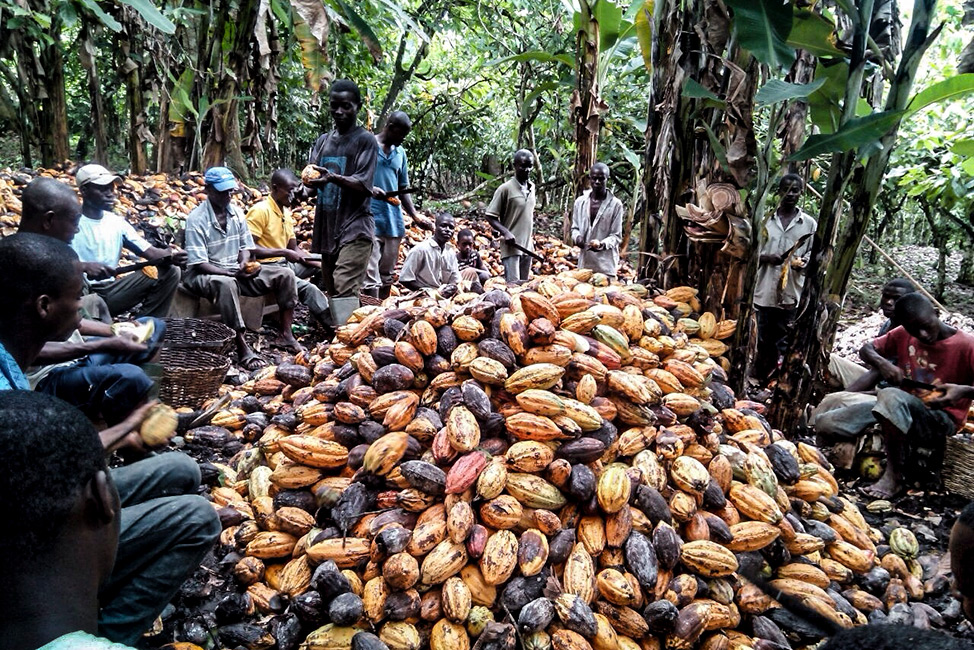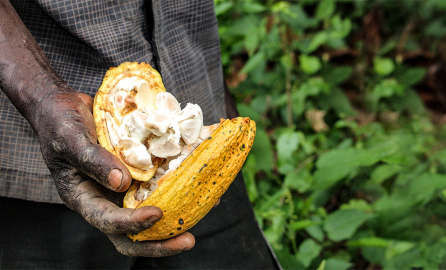In West Africa, more than two million children work in cocoa plantations, harvesting the raw product used for making chocolate and other high-value goods.
As countless numbers of these children miss out on school, many are also regularly exposed to serious hazards and exploitation, climbing cocoa trees to cut bean pods with heavy and sharp machetes, often with only limited access to fresh water, proper food and housing.
In Côte d’Ivoire and Ghana, two of the world’s largest producers of cocoa, an estimated 2.1 million children are engaged in some form of child labour in the cocoa supply chain. Most of these children begin working at a young age to help support their families, with some reports identifying plantation workers as young as five.

Around 2.1 million children are engaged in some form of child labour in the cocoa supply chain in Côte d’Ivoire and Ghana, two of the world’s largest producers of cocoa
“This is about poverty”
Since 2000, international organisations and journalists have brought this widespread issue to public attention, but progress has been inadequate or slow at best.
In March, the European Commission’s Directorate-General for International Cooperation and Development (DG DEVCO) organised a workshop bringing together the different stakeholders in the cocoa industry.
With representatives from labour organisations, European institutions, producing countries, NGOs and the industry, the one-day workshop, Cocoa, an unsavoury sweet?, aimed to assess progress, and share practices and challenges to eradicating child labour from cocoa production.
“It’s unthinkable that such extreme forms of child labour still exist in the 21st century,” said policy officer Maria Rosa De Paolis from DG DEVCO Unit B3, which covers employment and social inclusion, and which organised the workshop. “This is about the issue of poverty, first and foremost. Here, in Europe, we pay so much for chocolate, but the producers who grow the raw product barely get anything. They live in poverty […] they can’t afford to send their children to school.”
Through presentations, discussions and group work, the workshop identified the gaps and opportunities to ending child labour in the cocoa production and value chains.
“We have to tackle this issue with utmost urgency,” said De Paolis. “The Sustainable Development Goals state that by 2025 we have to completely eradicate child labour in all its forms. To achieve this, we need determined action across all levels – from the producers and fair labour organisations all the way to the highest international levels, where the price of cocoa is negotiated.”
For more on the workshop, watch the following video:
Nestlé is one of the world's biggest chocolate producers, and, since 2012, the so-called Child-Labour Monitoring and Remediation System (CLRMS) has helped the company identify over 7,327 cases of child labour, and address at least 5,232 of them.
Another proposed strategy came from the Stop Child Labour Coalition, which advocates for an area-based approach to eliminating child labour. SCL promotes the establishment of the so-called “child-labour free zones”, where children are systematically being taken away from labour and reintegrated into formal, full-time schools.
The practice, while currently not in use in the cocoa industry, has seen considerable impact in the garment and mining industry in India, helping withdraw more than a million children from work and guide them into school.
“Legal instruments are not enough”
Jean-Louis Ville, former Acting Director of the Directorate for People and Peace at DG DEVCO, echoed De Paolis’ words on the importance of cooperation in the workshop’s opening message.
“If we want to address child labour comprehensively as a macro-level phenomenon, we need to first reduce poverty and inequality,” Ville told Capacity4dev. “There are many global laws and regulations around child labour, and this is certainly very useful, but legal instruments are not enough on their own.”
While the workshop focused on the cocoa industry, it aimed to provide strategies that can be adapted to other sectors, De Paolis said.
For the best practices presented at the workshop, watch the following video:
“The idea behind the workshop was to come up with some operational conclusions that could be further developed for future interventions,” she said. “We decided to focus on the cocoa sector because there you can easily see the entire value chain. The consumers can see a direct link between the raw material and the final product.”
The EU is the world’s largest importer of cocoa, making up for nearly half of all cocoa beans consumed worldwide, according to the European Parliament. This, said Ville, should be used as a leverage in tackling child labour in cocoa production.
“As the EU, of course, we cannot decide for the producing countries how to address this issue,” he said. “But together we can see what approaches work. This is where a workshop like this serves a great purpose – it puts around the table all the different actors. Otherwise, we will continue trying to solve the issue of child labour from one end or another, without ensuring a strong impact across the whole chain.”
This article was written by Bartosz Brzezinski, Editorial Coordinator at Capacity4dev

Log in with your EU Login account to post or comment on the platform.